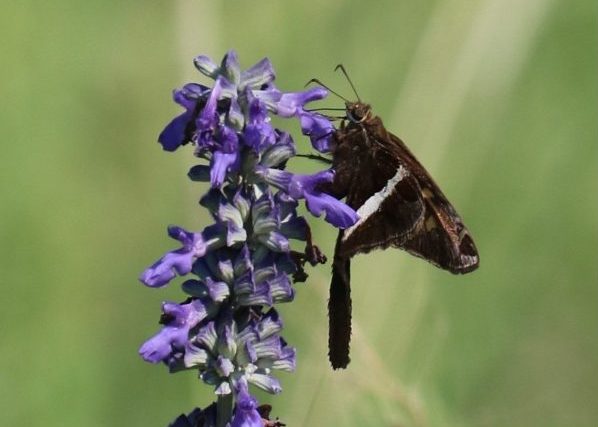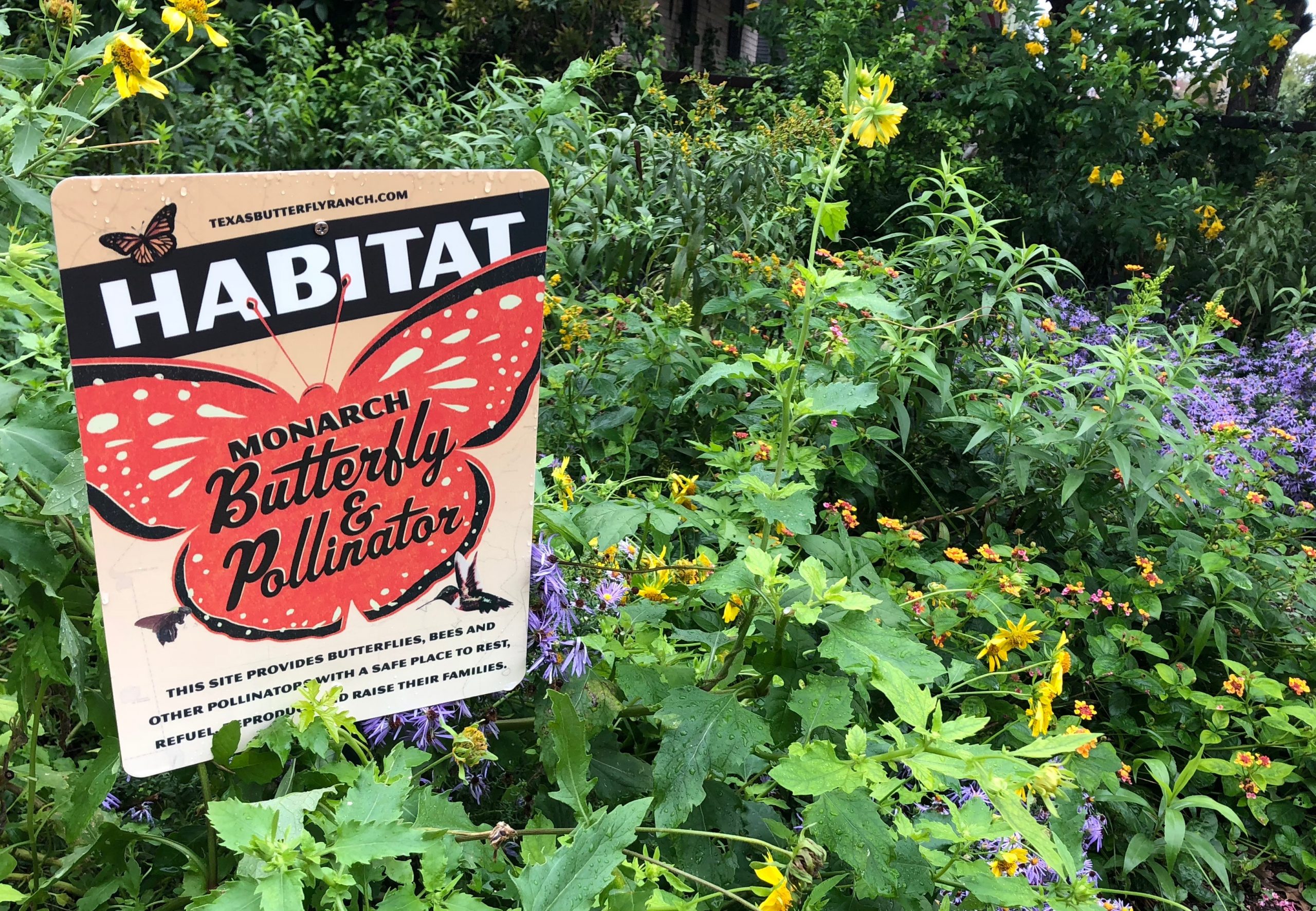Votes are in for the 2023 Unofficial Pollinator Plant of the Year and Mealy Blue Sage snags the title with 67% of the vote.
“It’s been a favorite of mine for years,” said Lee Marlowe, president of San Antonio’s Native Plant Society, which partners with the Texas Butterfly Ranch on executing the poll. Citing it “one of the best all-around native plants for landscapes in our area” Marlowe noted how bumblebees and bees tend to congregate on the flowers, while Lesser Goldfinches love eating the seeds. (See her photos above and below, as proof.) And, as a member of the mint family, its fresh, aromatic scent makes it relatively deer resistant.
The poll launched January 25 and closed at midnight last night with 319 votes cast.
Nancy McClintock, Treasurer for the Gardening Volunteers of South Texas, another partner in the annual poll, also sang the praises of Salvia farinacea.
“Drought tolerant, a perennial that repels insects, is non-invasive, requires little to no fertilizer, attracts bees and butterflies and is deer resistant,” she said, labeling Mealy Blue Sage one of the “super plants of our region.”

Sonoran bumble bee nectars on Mealy Blue Sage.–Photo by Lee Marlowe
“Luckily, both of this year’s competitors are some of the easier natives to find in the nursery trade,” said Donald Gerber, owner of Pollinatives, a native plant nursery that launches this spring in Converse, Texas. Gerber added that bees–especially bumble bees–LOVE Mealy Blue’s blossoms. Gerber said that when his nursery opens later this spring, Mealy Blue Sage will be on the menu, in 4-inch and one gallon pots.
Other local nurseries said they’ll be carrying Mealy Blue Sage once spring shipments arrive in a couple of weeks.
Brandon Kirby of San Antonio’s Rainbow Gardens recommended gardeners ask for the Henry Duhlburg cultivar which exhibits higher disease resistance and that Rainbow Gardens will be “opening the flood gates” with Mealy Blue Sage in March when spring orders arrive. With reports of El Niño passing through town later this week with another possible freeze, holding off on plant purchases is wise.
For those who can’t wait, seeds for Mealy Blue Sage are available at Native American Seed.
Mealy Blue Sage grows 18-36 inches tall and 18-36 inches wide. Its lance-shaped grey-green leaves jut from its four-sided spikes, and support the dramatic blooms that grace the plant from from April until frost. While the flowers general appear violet or blue, they can also show white, with two stamens and a pistil. Seeds may be collected following flowering.
Mealy Blue Sage thrives in full sun and partial shade, but blooms most prolifically with more sun.
The Texas native requires supplemental water during its first season in the garden, but once established, is pretty much maintenance free.
Read more about Mealy Blue Sage, Salvia farinacea and runner up Zexmenia, Wedelia acapulcensis var. hispida.
The Unofficial Pollinator Plant of the Year initiative, started in 2019 by the Texas Butterfly Ranch, came about to raise awareness of the unsung plant heroes of the pollinator garden. Many worthy, native plants are commercially unavailable, often only accessible during seasonal pop-up plant sales.
Commercial and retail nurseries often cite “lack of demand” as the reason for these plants’ absence in their stores. Our citizen gardener effort aims to create demand that will result in more native plants at gardening centers, local nurseries and big box stores.
When shopping for plants for your pollinator garden, look for Mealy Blue Sage or Zexmenia. If you don’t find them, help raise awareness by asking local plant suppliers to stock these worthy natives. If you request these plants each time you visit your favorite local nursery, big box store, or gardening center, buyers and suppliers will get the message that demand exists.
Our successful Pollinator Habitat Initiative has demonstrated that when gardeners take action, we can make a difference.
In 2018, we set out to create 300 pollinator gardens for San Antonio’s 300th birthday. By years’ end, we had pledges for 325 gardens, exceeding our goal by almost 10 percent. In 2019, we pushed for 500 gardens by 2020 and hit the mark by year’s end with 510 gardens pledge. Most recently, we set a goal of 1,000 pollinator gardens by 2023 and to date, 1,036 pollinator habitats have been pledged.
Thanks to everyone who has helped make this initiative a success.
Want to join us? Check out the map and pledge to plant a pollinator garden by registering here.
Want to tell the world why your garden looks the way it does? Check out the pollinator habitat signs available in our shop.
Mealy Blue Sage joins Gayfeather, Frostweed, Gregg’s mistflower and Cowpen Daisy as our fifth Unofficial Pollinator Plant of the Year. For more info and growing tips, check out our Resources page.
TOP PHOTO: White lined sphinx moth rests on Mealy Blue Sage. –Photo by Lee Marlowe
Related posts:
- Please vote! Mealy Blue Sage or Zexmenia for 2023 Unofficial Pollinator Plant of the Year?
- 2022 Unofficial Pollinator Plant of the Year: Engelmann’s Daisy or Gayfeather? Please vote!
- Cowpen daisy: Unofficial pollinator plant of the year 2019
- 2020 Unofficial pollinator plant of the year: Gregg’s mistflower
- How to plan a successful butterfly garden
- Mostly native butterfly garden outperforms lawn every time
- A year in the life of an urban butterfly garden
- Downtown River walk plot converts to pollinator garden, creature haven
- Converting your Lawn to a Butterfly Garden
- San Antonio becomes first National Wildlife Federation Monarch Champion city
- Tropical Milkweed: To Plant it or Not is Not a Simple Question
Like what you’re reading? Don’t miss a single post from the Texas Butterfly Ranch. Sign up for email delivery, like us on Facebook, or follow us on Twitter, @monikam.



Leave A Comment